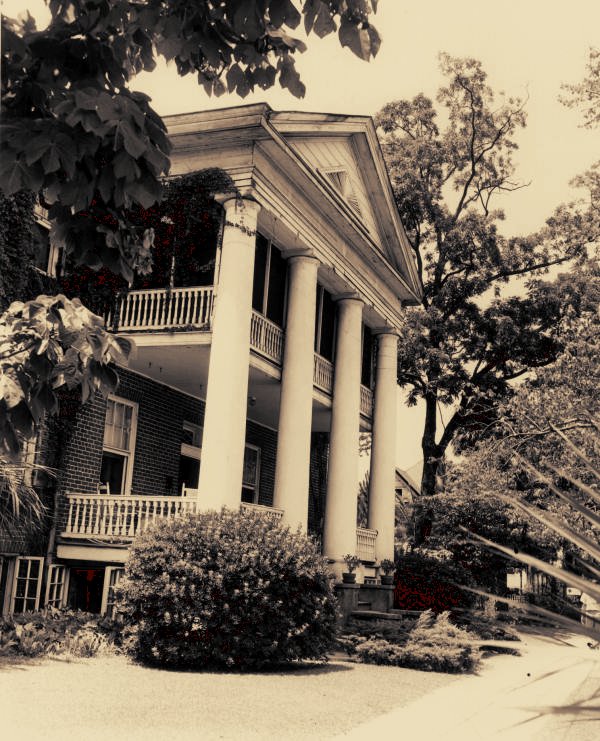
History of "The Columns"
by The James Madison Institute
|
HOME and BANK William "Money" Williams purchased the land on November 23,1829 and moved into the completed house in early 1831. Williams came to Tallahassee in 1827-1829 as he saw an opportunity in the frontier area's need of an organized bank. The house was constructed along what is now Park Avenue with a banking wing to the east along Adams Street. He had originally opened the Bank of Florida in 1830 at what is now the corner of Adams and College Streets. When constructed the house had four columns and 14 fireplaces. The main house had a central hall with two rooms on each side and the banking wing was attached to the east end. The architectural style would probably be considered Greek Revival. In 1833 Williams moved his family to Athens, Georgia and sold the building to the Central Bank of Florida which had been organized by Benjamin Chaires. Whether Chaires lived in the building is not really known. His country mansion Verdura was only 8 to 12 miles east of town. He may have used the house on occasion and reports indicate it was used for women and children during Indian raids. In 1838 the Union Bank absorbed the Central Bank. And, in 1841 a separate building for the Union Bank was built behind the Columns on Adams Street.
OFFICE BUILDING
BOARDING HOUSE
HOME AND DOCTOR'S OFFICE Also in 1867 the Union Bank building was rented to the National Freedmen's Saving and Trust Company and then sold to them in 1869. In 1897 the home was purchase by Thomas Roberts as a present for his wife Sarah Roberts. It was reportedly Sarah who gave the building the name of THE COLUMNS. Thomas died in 1901 and Sara married Henry Felkel in 1905 while continuing to reside in the home. She is credited with "updating" the home including removing the vault from the banking wing, which had extended to the east of the building, but leaving the vault's brick foundation, and altering the small west porch.
OFFICE BUILDING
RESTAURANT AND RENTALS The Dutch Kitchen Restaurant was such a success that in 1931 Dixie M. Hollings real estate handled the purchase of the building for Dutch Kitchen's owners Ada Clark and Ethel Stewart. With the restaurant in the banking wing basement the remainder of the house was rental space. A chiropractic office rented the banking room and later Ms. Clark lived there. In the 1930s Mrs. Stewart had a 2nd floor apartment in the building. For over thirty years it was not only a prosperous business but also a local institution so well known that there was little need for advertising. Part of its appeal was derived from its staff of waitresses, drawn largely from the Florida State College for Women (FSCW). It also served as a popular rendezvous for the younger set and a favorite eating place for the public in general.
CHURCH AUXILIARY SPACE
LIBRARY
SAVING THE HISTORIC BUILDING
QUICK FACTS - The home features a Dominican mahogany handrail on the staircase, five and a half inch wide pine plank floors, plaster lathe walls, 14 fireplaces linked to two bifurcated chimneys, and spacious porches on both the first and second floors. - When "The Columns" was still known to have ties with the banking industry, it used to be said that William "money" Williams hid a nickel (nickels used to be worth something!) in every brick used in the building. It was common practice for Tallahassee children to scratch away the soft clay bricks, but after years of nothing being found the story became a tall tale. - A second staircase used to exist in the small storage space in the library. It was said that Money Williams constructed this staircase out of fear of his daughter eloping. The stairs ran straight through his bedroom, therefore he could always know when his daughter wished to go downstairs. - The Ghost of Rebecca - Rebecca Bailey's spirit is said to roam the building searching for her husband. General William Bailey, who didn't return from the Civil War. There is no record that Bailey was ever a General, and evidence indicated that he was around Tallahassee well after the war. However, a former custodian at the Chamber of Commerce recounts that he was working in the yard one misty Saturday when he saw a woman in a long dress enter a basement doorway. He called out that the offices were closed and followed her as she climbed to the main level and then up the main stairs to the second floor, where she vanished. Due in large part to the legend of Rebecca, The Columns is one of the sites visited on the official Downtown Tallahassee Ghost Tour. |
Back | Home | Verdura Plantation
Don Draughon's e-mail